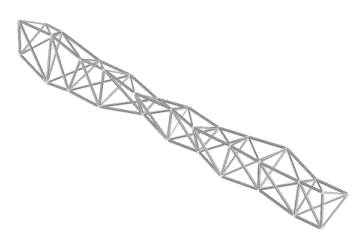One of the bedrock claims of creationism is that mutation can never create new information, that random changes can only make complex systems worse and never improve them. Although there are many examples of information-increasing mutations in the natural world that prove this claim false, there’s an even more potent and understandable counterexample, one that I think defenders of evolution too often overlook. That counterexample comes in the form of evolutionary algorithms.

Evolutionary algorithms are a type of computer simulation that uses evolution as a design tool. In an EA, the problem to be solved is represented as a fitness function, a quantitative metric that measures how well a proposed solution meets the parameters of the problem. An EA begins with a population of candidate solutions, usually generated at random, and uses the fitness function to evaluate each of them. The best candidates are copied with random mutations, creating “offspring” that go on to the next generation, and the process repeats. Some EAs even simulate sex by allowing candidate solutions to swap parts of their code.
As simple as this sounds, evolutionary algorithms have proven their worth as a problem-solving strategy of dramatic creativity and power, often producing solutions that surpass the best efforts of human engineers. EAs are widely used in academia and industry to get a handle on problems that seem intractable by any other method.
EAs have two major advantages over human design techniques. One is their open-mindedness. Because EAs operate through randomness, mutating their candidate solutions without trying to predict in advance whether the changes will be beneficial, they are not limited by human preconceptions about how a problem should be approached. The only thing that “matters” to an EA is results, and as a consequence, they often come up with solutions that a human designer would never have thought of.

The other advantage, more subtle, is called the Schema Theorem. Many important problems in industry and science exhibit combinatorial explosion – that is, they have so many different possible solutions that it would be impossible to individually test each one, even on a computer. This vast number of candidates can be grouped into what are called search spaces, collections of individuals that are similar in important ways. The idea behind an evolutionary algorithm is that, by evaluating an individual from a given search space, it’s learning something about all the individuals in that search space. As it repeats this process, it will gradually build up more and more accurate information about the average fitness values of these spaces, until it can home in on the one that’s most likely to contain the answer being sought. This sounds complicated, but fundamentally it’s the same thing that a scientific poll does. Pollsters ask questions of a certain member of an ethnic, religious or social group because they expect to learn something about the opinions of all members of that group, and therefore gain the ability to predict national opinion after sampling only a small fraction of the population.
But far more important than these theoretical concerns is the empirical evidence demonstrating the power of evolutionary algorithms, and the facts do not disappoint. EAs have been used throughout academia, industry and government to solve problems that seemed insoluble or to come up with answers that outclass their best human-designed competitors. They have been taught to play expert checkers, to design wings for supersonic aircraft, to predict stock market swings and currency exchange rate fluctuations, to schedule assembly lines and air traffic, to control automobile anti-lock braking systems, to optimize engines and turbines, and many more. Here are some other examples of evolutionary algorithms in the news over the past few months:
- In conjunction with an optical simulator called KOJAC, an EA designed by the computer science professor John Koza evolved a wide-field compound lens for telescopes and binoculars which outperforms a human-designed lens patented just six years ago. Professor Koza’s website lists 36 other instances where EAs have produced human-competitive results.
- EAs are used by Air Liquide, a U.S.-based industrial gas company, to efficiently schedule the operation of its plants and pipelines, producing results which save “a good deal of money over the solutions generated by commercially-available supply chain software”.
- EAs have designed USB flash-memory sticks that last up to 30 times longer than their predecessors, optimized the voltage and timing patterns of cochlear implants used to help the hard-of-hearing (often improving on the work of years of hand-tuning by doctors), and developed a Wi-Fi antenna that surpasses the capabilities of an existing design used by Cisco Systems.
- EAs were employed to find the weighting of variables for an algorithm that predicts failing companies two years in advance based on market data with a 90% accuracy rate.
- EAs successfully predicted the atomic structure of a newly discovered crystalline form of boron. The article adds, “This [same] algorithm had previously revealed new phases of iron sulfide, calcium carbonate, sulfur and even a superconducting form of oxygen, subsequently confirmed by experiment.”
The next time an ignorant creationist insists that evolution can never produce anything complex, functional and useful, point him to the evidence of evolutionary algorithms. These algorithms permit us to view evolution at work in real time, and in human technology, as in organic life, it proves to be a problem-solving strategy of surpassing flexibility and power.